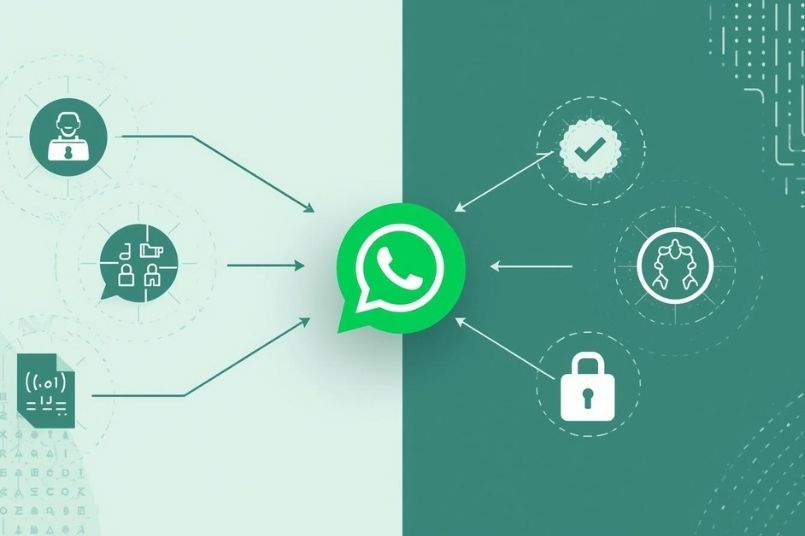WhatsApp KYC and Loan Journey Automation: India Guide

The document provides Indian lenders with a complete framework to create WhatsApp-based KYC and loan processes which follow regulations and maximize conversion rates throughout the entire journey from opt-in to verification and underwriting and disbursal and servicing and collections. The guide focuses on consent architecture and RBI-compliant practices and core system integration while offering message examples and end-to-end flow designs and measurement frameworks to speed up go-live processes and minimize operational challenges.
Why WhatsApp for lending in India
The immediate nature of WhatsApp enables users to complete KYC requirements and underwriting processes and repayment discussions at the highest level of responsiveness. The platform enables borrowers to progress through guided steps at a faster rate than email and IVR systems because it minimizes obstacles through fast responses and multimedia content and user interface elements that users already know. The platform enables multilingual journey delivery at scale through its support of English and Hindi and regional languages which maintains consistent delivery with auditable records and centralized governance. The combination of these factors leads to better completion rates and faster decision-making and improved recovery results which benefits digital lending models and distributed NBFC operations.
Compliance‑first approach for India
The process of compliance starts with obtaining direct consent from users for KYC and loan processing and servicing purposes while specifying the exact information usage. The consent process requires timestamp recording and channel identification and policy version documentation with permanent opt-out options to honor borrower choices. The system must minimize sensitive information collection by obtaining only necessary attributes while using tokenization and masking techniques to protect data in agent consoles and chat transcripts. The described workflow meets Indian regulatory requirements by supporting digital KYC and video KYC and scheduled KYC updates and maintains complete audit records for all templates and decision-making processes and override actions and exceptions.
End‑to‑end journey blueprint
The acquisition process starts immediately when a customer shows interest through WhatsApp click ads or website chat transfers or branch or DSA desk QR codes or missed call promotions. The first contact requires borrowers to give permission while collecting basic information including name and city and PAN card last four digits before showing an eligibility prediction tool for future actions. The data collection process through progressive profiling happens across multiple brief interactions instead of requiring users to fill out a single extensive form which helps minimize drop-off rates. The KYC process begins with a template which verifies the purpose of the application and details the required documents for verification including a PAN image with mask and acceptable proof of address. The system enables secure document upload followed by automatic extraction through OCR and validation while it sends intelligent alerts for missing information and moves to agent assistance for unresolved document mismatches.
The process of scheduling video KYC for regulated journeys starts with a user-friendly slot selection interface which leads to a pre-call checklist for applicants to prepare their required identification documents. The verification process must implement liveness detection and geo-tagging when necessary while it should redirect failed attempts to assisted verification without requiring borrowers to start over from previous steps. The system needs to obtain employment details and salary information and bank credit data and consent for bureau data retrieval before it connects to bureau services and bank statement analysis and alternative data processing systems while providing ongoing status updates to the applicant.
The system requires approval before presenting the offer through clear and fair terms which include the sanctioned amount and APR or IRR and processing charges and prepayment conditions and an in-chat EMI calculator for different loan periods. The system allows eSign handoff and eMandate setup during the same session to guide applicants from offer approval to completion before sending a brief disbursal confirmation that includes verified bank details and payment schedules. The system sends a welcome message after disbursal which provides details about EMI payments and statement access and payment rescheduling and issue reporting while establishing friendly reminder protocols. The system will send service-oriented and respectful notifications to customers about part-prepayment options and top-up eligibility and cross-sell promotions during the loan period.
The payment journey should include adaptive logic that adjusts content and tone based on the current stage of the payment process to provide users with straightforward payment options or extended timeframes or direct access to live support. The system should use UPI or payment gateways for immediate payment options in early buckets while collecting precise payment promises with timestamps for receipt verification. The system needs to provide users with an easy way to ask for help while connecting them directly to authorized staff who can implement suitable payment arrangements.
Key WhatsApp features to use
Interactive components like quick replies and lists steer borrowers through compliant paths while cutting down typing errors and confusion. Stepwise forms and structured flows handle PAN, address, employment details, and declarations with validation at each step. Rich media allows for masked ID uploads and concise sharing of offer terms, mini‑statements, and welcome kits. Language preferences can be captured early to present English by default and seamlessly switch to the borrower’s chosen regional language later. At critical points, a human agent should be able to take over the conversation with full context and preserved consent metadata, ensuring that the borrower never has to repeat information.
Template pack (examples to adapt per policy)
The KYC initiation message verifies the application purpose and disclosure of opt-out options before prompting the applicant to start the process immediately. The system shows a particular missing document to users through a one-click agent assistance feature. The video KYC reminder system displays appointment details and required documents to the user while approval notifications present essential loan information through eSign access. The EMI reminder system delivers brief information about payment alternatives and provides a polite method to request more time before showing the payment options. The early collection stage presents users with three payment choices that include fast payment and extended time or agent assistance without using judgmental language. The system maintains compliance while providing human treatment to users through efficient processes that honor their opt-out preferences at all times.
Integrations architecture
The operational backbone depends on two-way synchronization between CRM and LOS or LMS systems to maintain consistent lead states and KYC status and underwriting milestones and disbursal events and EMI schedules between teams. The system integrates PAN and Aadhaar identity verification partners with OCR and face-match systems to decrease manual work and enhance validation speed. The system uses credit bureau connectors and bank statement analyzers and decisioning webhooks to automate workflow progression while sending real-time status updates to WhatsApp. The payment infrastructure which supports UPI and cards and eMandates must send immediate user journey continuation callbacks after users confirm their payments. The system should transmit detailed event data about consent and starts and completions and turnaround times and satisfaction and containment and recovery at the bucket level to a central dashboard for ongoing improvement.
Security and governance
All data transmission and storage requires encryption protection through vault storage systems which grant access to authorized personnel only. The system should implement Redaction guardrails to hide PAN and Aadhaar patterns in conversational logs while automated data-loss prevention rules should prevent users from entering complete ID information with full date of birth in free text. The system must include specific retention rules for each data category with scheduled deletion procedures and complete logging of all system activities for internal and regulatory examination purposes. The method decreases security threats while establishing trust with borrowers because it maintains open and dignified data management practices.
Success metrics to track
Success begins with acquisition metrics such as opt‑in rate, cost per lead into WhatsApp, and eligibility conversion, then moves into KYC performance like start‑to‑complete ratios, average KYC turnaround time, video KYC show rates, and document rejection rates. Underwriting should be monitored for data sufficiency, decision turnaround, and approval rates by segment, while disbursal focuses on eSign completion, eMandate success, and first‑EMI performance. In servicing, containment within self‑service, satisfaction scores, and escalation handling time point to operational health. For collections, promise‑to‑pay adherence, digital payment share, days‑past‑due movement, and cure rates reveal the strength and ethics of recovery strategies.
India‑specific best practices
India travel experiences need distinct consent options for marketing communications and transactional or servicing messages to prevent confusion and preserve customer trust. The language needs to be easy to understand and remember while keeping all copy brief and simple with actions that function properly on mobile devices. The system should use structured forms with controlled handoffs for sensitive information instead of free text entry to minimize errors and data leaks and reminder scheduling should consider salary periods and festival dates to minimize user inconvenience. The implemented considerations enhance operational efficiency and cultural sensitivity while safeguarding customer information.
Sample journeys
The digital KYC process starts with pre-approved leads who opt-in before verifying their PAN card last four digits and birth month followed by address proof collection and video KYC scheduling and final completion verification with liveness failure escalation. The personal loan process from approval to disbursal includes showing the offer details followed by borrower selection of terms and amount before moving to eSign and eMandate processes which end with a clear disbursal confirmation after APR and total cost acknowledgment. The early-bucket collections process begins at three days past due with a polite reminder followed by immediate payment options through UPI and other payment systems and an instant receipt and two payment options to choose from or request assistance before the system logs and follows up accordingly.
Governance and reviews
The process of reviewing templates four times a year helps maintain alignment with RBI standards and internal communication protocols and ensures that FAQs stay relevant to actual borrower inquiries. The risk models and computer vision systems that perform OCR and face matching and fraud prevention need periodic validation for detecting drift and bias while monitoring false accept and reject rates for correction. The review process for vendor posture must occur frequently to evaluate messaging and verification and payment partners through assessments of uptime and certifications and incident records and data protection terms in contracts. The scheduled review process maintains both operational stability and regulatory compliance throughout extended periods.
How Waliner.io helps
The unified flow builder of Waliner enables business and compliance teams to create a single canvas that combines KYC steps with video KYC scheduling and underwriting webhooks and payments through an iterative process without requiring extensive engineering work. The consent and compliance engine of the system automatically records consent based on purpose while it hides sensitive information in real time and enforces template and data protection rules to integrate risk management into regular business operations. The platform features preconfigured connections to standard CRM and LOS and LMS systems and identity verification services and bureau and bank statement analyzers and payment rails and analytics pipelines which minimize integration work and accelerate time-to-value. The platform enables human agents to intervene through full conversational context while following role-based permissions and detailed audit trails and it supports national-scale programs through its throughput capabilities and fallback routing and multilingual management features.
Implementation timeline
Most lenders need about four weeks to transition from discovery to production. The first week of the process involves requirements gathering and consent design work and template creation and sandbox preparation. The second week of development includes building KYC flows and verification systems and video KYC integration with LOS or LMS systems for live synchronization. The third week of development includes underwriting webhooks integration and offer and signing sequence completion and payment orchestration finalization. The fourth week of development focuses on completing servicing and collections journeys and dashboards and regression testing and go-live runbooks to ensure successful launch operations.
FAQ
Q: Is WhatsApp KYC compliant in India?
A: Yes, when consent is explicit and purpose‑specific, sensitive data is minimized or masked, and verification is conducted by compliant partners with full audit logging suitable for internal and external reviews.
Q: Can video KYC be handled via WhatsApp?
A: Yes, it can be scheduled and initiated from a WhatsApp journey and conducted in a secure session, with evidence stored according to policy and outcomes synchronized to LOS or LMS without losing conversational context.
Q: How are repayments handled?
A: Repayments can be supported through compliant reminders containing UPI or payment‑gateway links, precise promise‑to‑pay capture, and respectful escalation to agents for hardship assistance or rescheduling where policy allows.
Q: What metrics matter most?
A: The most important metrics typically include KYC completion and turnaround time, underwriting decision time and approval ratios, eSign and mandate success before disbursal, containment and satisfaction in servicing, and digital recovery share along with cure rate in collections.






Review WhatsApp KYC and Loan Journey Automation: India Guide.